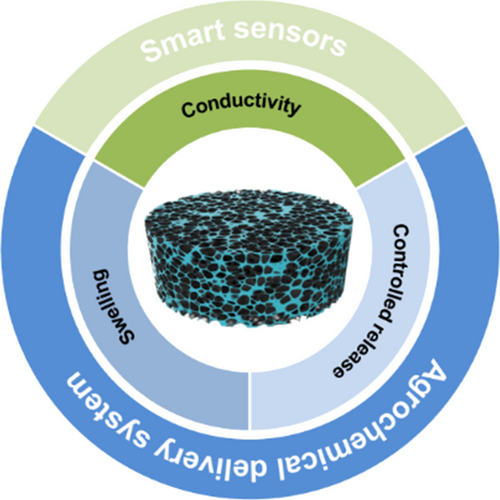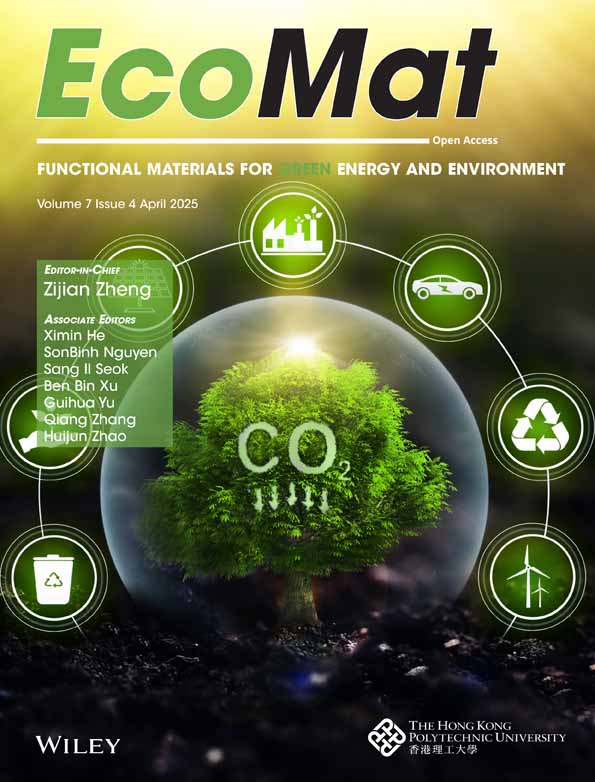Smart Hydrogels for Sustainable Agriculture
Jungjoon Park
Materials Science and Engineering Program and Walker Department of Mechanical Engineering, The University of Texas at Austin, Austin, Texas, USA
Search for more papers by this authorWeixin Guan
Materials Science and Engineering Program and Walker Department of Mechanical Engineering, The University of Texas at Austin, Austin, Texas, USA
Search for more papers by this authorCorresponding Author
Guihua Yu
Materials Science and Engineering Program and Walker Department of Mechanical Engineering, The University of Texas at Austin, Austin, Texas, USA
Correspondence:
Guihua Yu ([email protected])
Search for more papers by this authorJungjoon Park
Materials Science and Engineering Program and Walker Department of Mechanical Engineering, The University of Texas at Austin, Austin, Texas, USA
Search for more papers by this authorWeixin Guan
Materials Science and Engineering Program and Walker Department of Mechanical Engineering, The University of Texas at Austin, Austin, Texas, USA
Search for more papers by this authorCorresponding Author
Guihua Yu
Materials Science and Engineering Program and Walker Department of Mechanical Engineering, The University of Texas at Austin, Austin, Texas, USA
Correspondence:
Guihua Yu ([email protected])
Search for more papers by this authorFunding: This work was supported by Welch Foundation, F-1861.
ABSTRACT
The growing global population, coupled with increasing food demand and water scarcity, has intensified the need for advancements in modern agriculture. As an emerging class of materials featured by intensively tunable properties, smart hydrogels offer innovative solutions to challenges associated with conventional agricultural practices, such as excessive agrochemical and water use and inefficiencies that contribute to environmental degradation. Additionally, hydrogel-based sensors can monitor environmental conditions and crop health, enabling precise adjustments to optimize growth and resource use. By serving as platforms for the slow and controlled delivery of agrochemicals and smart sensors, hydrogel systems can enhance resource efficiency, reduce labor demands, and improve crop yields in an environmentally sustainable manner. This Perspective article summarizes recent advancements in hydrogel-based materials, highlights existing challenges, and proposes potential research directions, with a focus on developing advanced hydrogel systems to transform agricultural practices.
Conflicts of Interest
The authors declare no conflicts of interest.
References
- 1 United Nations, “Global Issues,” https://www.un.org/en/global-issues/population.
- 2M. van Dijk, T. Morley, M. L. Rau, and Y. Saghai, “A Meta-Analysis of Projected Global Food Demand and Population at Risk of Hunger for the Period 2010–2050,” Nature Food 2 (2021): 494–501.
- 3P. Greve, T. Kahil, J. Mochizuki, et al., “Global Assessment of Water Challenges Under Uncertainty in Water Scarcity Projections,” Nature Sustainability 1 (2018): 486–494.
- 4E. R. Jones, M. F. P. Bierkens, and M. T. H. van Vliet, “Current and Future Global Water Scarcity Intensifies When Accounting for Surface Water Quality,” Nature Climate Change 14 (2024): 629–635.
- 5H. Mansouri, H. Ait Said, H. Noukrati, A. Oukarroum, H. Ben Youcef, and F. Perreault, “Advances in Controlled Release Fertilizers: Cost-Effective Coating Techniques and Smart Stimuli-Responsive Hydrogels,” Advanced Sustainable Systems 7 (2023): 2300149.
- 6Y. Guo and G. Yu, “Materials Innovation for Global Water Sustainability,” ACS Materials Letters 4 (2022): 713–714.
- 7W. Shi, W. Guan, C. Lei, and G. Yu, “Sorbents for Atmospheric Water Harvesting: From Design Principles to Applications,” Angewandte Chemie, International Edition 61 (2022): e202211267.
- 8C. Lei, W. Guan, Y. Zhao, and G. Yu, “Chemistries and Materials for Atmospheric Water Harvesting,” Chemical Society Reviews 53 (2024): 7328–7362.
- 9X. Zhou, Y. Guo, F. Zhao, and G. Yu, “Hydrogels as an Emerging Material Platform for Solar Water Purification,” Accounts of Chemical Research 52 (2019): 3244–3253.
- 10Y. Guo, J. Bae, Z. Fang, P. Li, F. Zhao, and G. Yu, “Hydrogels and Hydrogel-Derived Materials for Energy and Water Sustainability,” Chemical Reviews 120 (2020): 7642–7707.
- 11J. Li and D. J. Mooney, “Designing Hydrogels for Controlled Drug Delivery,” Nature Reviews Materials 1 (2016): 16071.
- 12E. Priya, S. Sarkar, and P. K. Maji, “A Review on Slow-Release Fertilizer: Nutrient Release Mechanism and Agricultural Sustainability,” Journal of Environmental Chemical Engineering 12 (2024): 113211.
- 13D. H. H. Sim, I. A. W. Tan, L. L. P. Lim, and B. H. Hameed, “Encapsulated Biochar-Based Sustained Release Fertilizer for Precision Agriculture: A Review,” Journal of Cleaner Production 303 (2021): 127018.
- 14Z. Lang, S. Yan, and Q. Zhu, “Water Retention and Sustained Release of Magnesium-Based Biochar Modified Hydrogel Composite Materials,” Journal of Environmental Chemical Engineering 11 (2023): 111380.
- 15P. Wen, Z. Wu, Y. Han, G. Cravotto, J. Wang, and B. C. Ye, “Microwave-Assisted Synthesis of a Novel Biochar-Based Slow-Release Nitrogen Fertilizer With Enhanced Water-Retention Capacity,” ACS Sustainable Chemistry & Engineering 5 (2017): 7374–7382.
- 16S. K. Das and G. K. Ghosh, “Hydrogel-Biochar Composite for Agricultural Applications and Controlled Release Fertilizer: A Step Towards Pollution-Free Environment,” Energy 242 (2022): 122977.
- 17T. An, H. Cheng, Y. Qin, et al., “The Dual Mechanisms of Composite Biochar and Biofilm Towards Sustainable Nutrient Release Control of Phosphate Fertilizer: Effect on Phosphorus Utilization and Crop Growth,” Journal of Cleaner Production 311 (2021): 127329.
- 18Y. Cui, Y. Xiang, Y. Xu, et al., “Poly-Acrylic Acid Grafted Natural Rubber for Multi-Coated Slow Release Compound Fertilizer: Preparation, Properties and Slow-Release Characteristics,” International Journal of Biological Macromolecules 146 (2020): 540–548.
- 19S. Noppakundilograt, N. Pheatcharat, and S. Kiatkamjornwong, “Multilayer-Coated NPK Compound Fertilizer Hydrogel With Controlled Nutrient Release and Water Absorbency,” Journal of Applied Polymer Science 132 (2015): 41249.
- 20M. Salimi, E. Motamedi, B. Motesharezedeh, H. M. Hosseini, and H. A. Alikhani, “Starch-g-Poly(Acrylic Acid-Co-Acrylamide) Composites Reinforced With Natural Char Nanoparticles Toward Environmentally Benign Slow-Release Urea Fertilizers,” Journal of Environmental Chemical Engineering 8 (2020): 103765.
- 21J. Lu, M. Wu, L. Luo, et al., “Incorporating Iron Oxide Nanoparticles in Polyvinyl Alcohol/Starch Hydrogel Membrane With Biochar for Enhanced Slow-Release Properties of Compound Fertilizers,” Carbohydrate Polymers 348 (2025): 122834.
- 22T. Wu, K. Zhao, C. Zhang, et al., “Promising Delivery Platform for Smart Pest Control With High Water-Retaining Capacity,” ACS Applied Materials & Interfaces 14 (2022): 55062–55074.
- 23J. Singh, B. Singh, and Vishavnath, “Designing Starch–Alginate Hydrogels for Controlled Delivery of Fungicide for the Alleviation of Environmental Pollution,” ACS Agricultural Science & Technology 2 (2022): 1239–1250.
- 24L. Wang, G. Yu, J. Li, et al., “Stretchable Hydrophobic Modified Alginate Double-Network Nanocomposite Hydrogels for Sustained Release of Water-Insoluble Pesticides,” Journal of Cleaner Production 226 (2019): 122–132.
- 25Q. Zhang, G. Yu, Q. Zhou, et al., “Eco-Friendly Interpenetrating Network Hydrogels Integrated With Natural Soil Colloid as a Green and Sustainable Modifier for Slow Release of Agrochemicals,” Journal of Cleaner Production 269 (2020): 122060.
- 26R. Zhang, M. Tang, A. Bowyer, R. Eisenthal, and J. Hubble, “A Novel pH- and Ionic-Strength-Sensitive Carboxymethyl Dextran Hydrogel,” Biomaterials 26 (2005): 4677–4683.
- 27V. Kozlovskaya, E. Kharlampieva, M. L. Mansfield, and S. A. Sukhishvili, “Poly(Methacrylic Acid) Hydrogel Films and Capsules: Response to pH and Ionic Strength, and Encapsulation of Macromolecules,” Chemistry of Materials 18 (2006): 328–336.
- 28Y. Xiang, G. Zhang, C. Chen, B. Liu, D. Cai, and Z. Wu, “Fabrication of a pH-Responsively Controlled-Release Pesticide Using an Attapulgite-Based Hydrogel,” ACS Sustainable Chemistry & Engineering 6 (2018): 1192–1201.
- 29X. Zha, X. Hou, Q. Li, et al., “Loading Glyphosate in Attapulgite and Sodium Alginate Hydrogels to Construct pH-Responsive Controlled Release Microspheres for Enhanced Soil Sustained Release,” ACS Agricultural Science & Technology 2 (2022): 1090–1100.
- 30Y. Xiang, X. Lu, J. Yue, et al., “Stimuli-Responsive Hydrogel as Carrier for Controlling the Release and Leaching Behavior of Hydrophilic Pesticide,” Science of the Total Environment 722 (2020): 137811.
- 31G. Liu, G. Lin, M. Tan, et al., “Hydrazone-Linked Soybean Protein Isolate-Carboxymethyl Cellulose Conjugates for pH-Responsive Controlled Release of Pesticides,” Polymer Journal 51 (2019): 1211–1222.
- 32L. Zheng, F. Seidi, W. Wu, Y. Pan, and H. Xiao, “Dual-Functional Lignin-Based Hydrogels for Sustained Release of Agrochemicals and Heavy Metal Ion Complexation,” International Journal of Biological Macromolecules 235 (2023): 123701.
- 33C. Xu, L. Cao, C. Cao, et al., “Fungicide Itself as a Trigger to Facilely Construct Hymexazol-Encapsulated Polysaccharide Supramolecular Hydrogels With Controllable Rheological Properties and Reduced Environmental Risks,” Chemical Engineering Journal 452 (2023): 139195.
- 34S. Gu, M. Liu, R. Xu, et al., “Ecofriendly Controlled-Release Insecticide Carrier: pH−/Temperature-Responsive Rosin-Derived Hydrogels for Avermectin Delivery Against Mythimna Separata (Walker),” Langmuir 40 (2024): 10992–11010.
- 35D. Zheng, K. Wang, B. Bai, N. Hu, and H. Wang, “Swelling and Glyphosate-Controlled Release Behavior of Multi-Responsive Alginate-g-P(NIPAm-Co-NDEAm)-Based Hydrogel,” Carbohydrate Polymers 282 (2022): 119113.
- 36X. Hou, Y. Pan, H. Xiao, and J. Liu, “Controlled Release of Agrochemicals Using pH and Redox Dual-Responsive Cellulose Nanogels,” Journal of Agricultural and Food Chemistry 67 (2019): 6700–6707.
- 37W. Guan, Y. Zhao, C. Lei, and G. Yu, “Molecularly Confined Hydration in Thermoresponsive Hydrogels for Efficient Atmospheric Water Harvesting,” Proceedings of the National Academy of Sciences of the United States of America 120 (2023): e2308969120.
- 38F. Zhao, X. Zhou, Y. Liu, Y. Shi, Y. Dai, and G. Yu, “Super Moisture-Absorbent Gels for All-Weather Atmospheric Water Harvesting,” Advanced Materials 31 (2019): 1806446.
- 39J. Park, W. Guan, C. Lei, and G. Yu, “Self-Irrigation and Slow-Release Fertilizer Hydrogels for Sustainable Agriculture,” ACS Materials Letters 6 (2024): 3471–3477.
- 40X. Zhou, P. Zhang, F. Zhao, and G. Yu, “Super Moisture Absorbent Gels for Sustainable Agriculture via Atmospheric Water Irrigation,” ACS Materials Letters 2 (2020): 1419–1422.
- 41H. Zou, X. Yang, J. Zhu, et al., “Solar-Driven Scalable Hygroscopic Gel for Recycling Water From Passive Plant Transpiration and Soil Evaporation,” Nature Water 2 (2024): 663–673.
- 42L. V. Kayser and D. J. Lipomi, “Stretchable Conductive Polymers and Composites Based on PEDOT and PEDOT:PSS,” Advanced Materials 31 (2019): 1806133.
- 43B. Lu, H. Yuk, S. Lin, et al., “Pure PEDOT:PSS Hydrogels With High Electrical Conductivity, Stretchability, and Stability for Bioelectronics,” Nature Communications 10 (2019): 1043.
- 44C. Sun, X. Wang, M. A. Auwalu, S. Cheng, and W. Hu, “Organic Thin Film Transistors-Based Biosensors,” EcoMat 3 (2021): e12094.
- 45X. Q. Zhan, Z. Q. Ran, H. Y. Bao, et al., “Intelligent Hydrogel On–Off Controller Sensor for Irrigation,” Advanced Composites and Hybrid Materials 7 (2024): 6.
- 46X. Guo, L. Wang, Z. Jin, and C. Lee, “A Multifunctional Hydrogel With Multimodal Self-Powered Sensing Capability and Stable Direct Current Output for Outdoor Plant Monitoring Systems,” Nano Micro Letters 17 (2025): 76.
- 47H. H. Hsu, X. Zhang, K. Xu, et al., “Self-Powered and Plant-Wearable Hydrogel as LED Power Supply and Sensor for Promoting and Monitoring Plant Growth in Smart Farming,” Chemical Engineering Journal 422 (2021): 129499.
- 48Y. Wang, Y. Wang, Y. Xue, et al., “Portable and Flexible Hydrogel Sensor for On-Site Atrazine Assay on Agricultural Products,” Analytical Chemistry 96 (2024): 7772–7779.
- 49M. Gosecki, H. Setala, T. Virtanen, and A. J. Ryan, “A Facile Method to Control the Phase Behavior of Hydroxypropyl Cellulose,” Carbohydrate Polymers 252 (2021): 117015.
10.1016/j.carbpol.2020.117015 Google Scholar
- 50J. Gao, G. Haidar, X. Lu, and Z. Hu, “Self-Association of Hydroxypropylcellulose in Water,” Macromolecules 34 (2001): 2242–2247.
- 51Y. Li, C. Wang, Y. Luan, et al., “Preparation of pH-Responsive Cellulose Nanofibril/Sodium Alginate Based Hydrogels for Drug Release,” Journal of Applied Polymer Science 139 (2022): e51647.
- 52M. A. Abd El-Ghaffar, M. S. Hashem, M. K. El-Awady, and A. M. Rabie, “pH-Sensitive Sodium Alginate Hydrogels for Riboflavin Controlled Release,” Carbohydrate Polymers 89 (2012): 667–675.
- 53Y. Bai, Z. Zhang, A. Zhang, et al., “Novel Thermo- and pH-Responsive Hydroxypropyl Cellulose- and Poly (L-Glutamic Acid)-Based Microgels for Oral Insulin Controlled Release,” Carbohydrate Polymers 89 (2012): 1207–1214.
- 54S. Gan, S. Bai, C. Chen, et al., “Hydroxypropyl Cellulose Enhanced Ionic Conductive Double-Network Hydrogels,” International Journal of Biological Macromolecules 181 (2021): 418–425.
- 55A. Riofrio, T. Alcivar, and H. Baykara, “Environmental and Economic Viability of Chitosan Production in Guayas-Ecuador: A Robust Investment and Life Cycle Analysis,” ACS Omega 6 (2021): 23038–23051.





